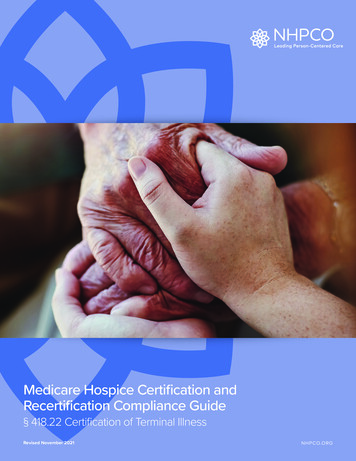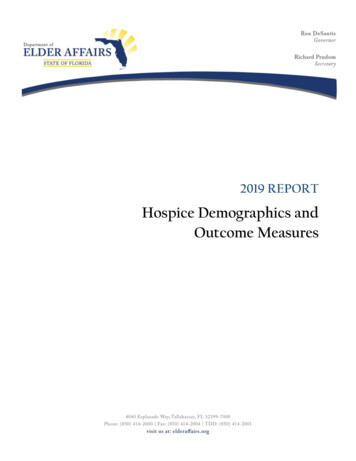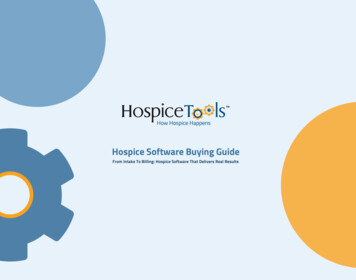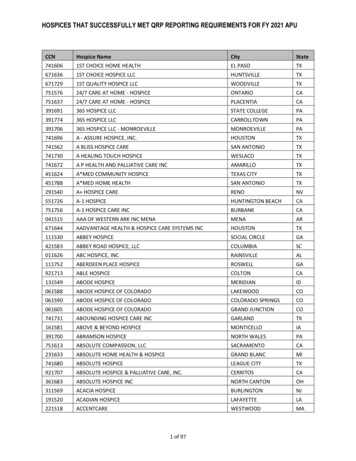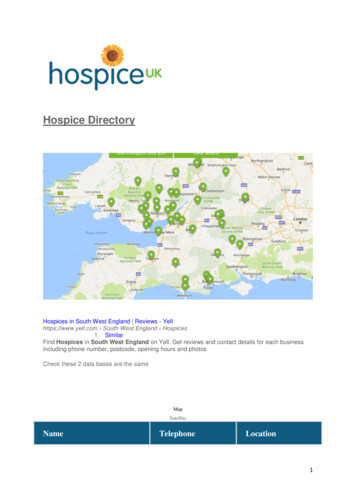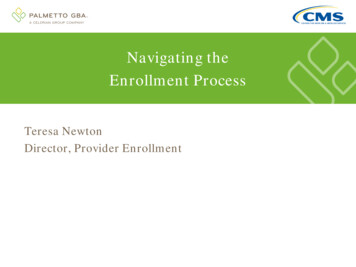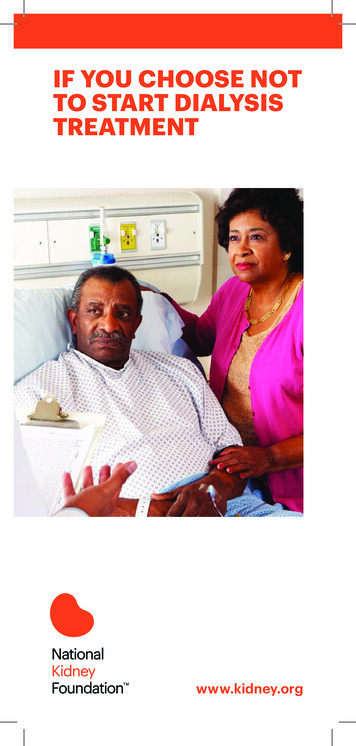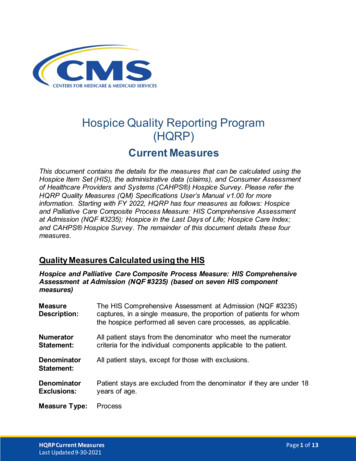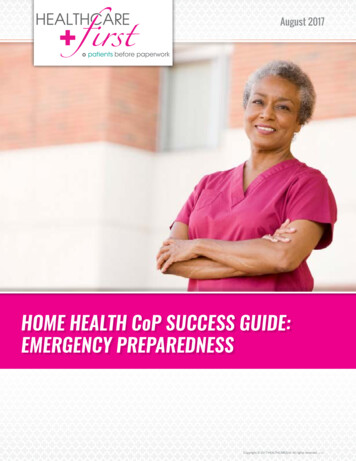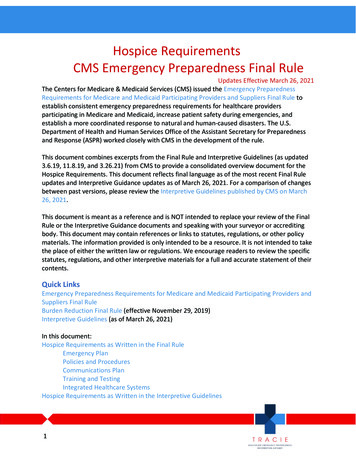
Transcription
Hospice RequirementsCMS Emergency Preparedness Final RuleUpdates Effective March 26, 2021The Centers for Medicare & Medicaid Services (CMS) issued the Emergency PreparednessRequirements for Medicare and Medicaid Participating Providers and Suppliers Final Rule toestablish consistent emergency preparedness requirements for healthcare providersparticipating in Medicare and Medicaid, increase patient safety during emergencies, andestablish a more coordinated response to natural and human-caused disasters. The U.S.Department of Health and Human Services Office of the Assistant Secretary for Preparednessand Response (ASPR) worked closely with CMS in the development of the rule.This document combines excerpts from the Final Rule and Interpretive Guidelines (as updated3.6.19, 11.8.19, and 3.26.21) from CMS to provide a consolidated overview document for theHospice Requirements. This document reflects final language as of the most recent Final Ruleupdates and Interpretive Guidance updates as of March 26, 2021. For a comparison of changesbetween past versions, please review the Interpretive Guidelines published by CMS on March26, 2021.This document is meant as a reference and is NOT intended to replace your review of the FinalRule or the Interpretive Guidance documents and speaking with your surveyor or accreditingbody. This document may contain references or links to statutes, regulations, or other policymaterials. The information provided is only intended to be a resource. It is not intended to takethe place of either the written law or regulations. We encourage readers to review the specificstatutes, regulations, and other interpretive materials for a full and accurate statement of theircontents.Quick LinksEmergency Preparedness Requirements for Medicare and Medicaid Participating Providers andSuppliers Final RuleBurden Reduction Final Rule (effective November 29, 2019)Interpretive Guidelines (as of March 26, 2021)In this document:Hospice Requirements as Written in the Final RuleEmergency PlanPolicies and ProceduresCommunications PlanTraining and TestingIntegrated Healthcare SystemsHospice Requirements as Written in the Interpretive Guidelines1TRAC I E
Hospice Requirements as Written in the Final Rule and as amended by 2019Burden Reduction (November 2019)The following excerpt is taken beginning on page 64024 of the Final Rule, accessible directly bythis link: -10 and Medicare and MedicaidPrograms; Regulatory Provisions To Promote Program Efficiency, Transparency, and BurdenReduction; Fire Safety Requirements for Certain Dialysis Facilities; Hospital and Critical AccessHospital (CAH) Changes To Promote Innovation, Flexibility, and Improvement in Patient Carepublished September 30, 2019 and effective November 29, 2019.PART 418—HOSPICE CARE7. The authority citation for part 418 continues to read as follows:Authority: Secs. 1102 and 1871 of the Social Security Act (42 U.S.C. 1302and 1395hh).§ 418.110[Amended]8. Amend § 418.110 by removing paragraph (c)(1)(ii) and the paragraph designation (i) fromparagraph (c)(1)(i).9. Add § 418.113 to read as follows:§ 418.113Condition of participation: Emergency preparedness.The hospice must comply with all applicable Federal, State, and local emergency preparednessrequirements. The hospice must establish and maintain an emergency preparedness programthat meets the requirements of this section. The emergency preparedness program mustinclude, but not be limited to, the following elements:(a) Emergency plan. The hospice must develop and maintain an emergency preparednessplan that must be reviewed, and updated at least every 2 years. The plan must do the following:(1) Be based on and include a documented, facility-based and community-based riskassessment, utilizing an all-hazards approach.(2) Include strategies for addressing emergency events identified by the risk assessment,including the management of the consequences of power failures, natural disasters, andother emergencies that would affect the hospice's ability to provide care.(3) Address patient population, including, but not limited to, the type of services thehospice has the ability to provide in an emergency; and continuity of operations,including delegations of authority and succession plans.2TRAC I E
(4) Include a process for cooperation and collaboration with local, tribal, regional, State,or Federal emergency preparedness officials' efforts to maintain an integrated responseduring a disaster or emergency situation.(b) Policies and procedures. The hospice must develop and implement emergencypreparedness policies and procedures, based on the emergency plan set forth in paragraph (a)of this section, risk assessment at paragraph (a)(1) of this section, and the communication planat paragraph (c) of this section. The policies and procedures must be reviewed and updated atleast every 2 years.At a minimum, the policies and procedures must address the following:(1) Procedures to follow up with on-duty staff and patients to determine services thatare needed, in the event that there is an interruption in services during or due to anemergency. The hospice must inform State and local officials of any on-duty staff orpatients that they are unable to contact.(2) Procedures to inform State and local emergency preparedness officials abouthomebound hospice patients in need of evacuation from their residences at any timedue to an emergency situation based on the patient's medical and psychiatric conditionand home environment.(3) A system of medical documentation that preserves patient information, protectsconfidentiality of patient information, and secures and maintains the availability ofrecords.(4) The use of hospice employees in an emergency and other emergency staffingstrategies, including the process and role for integration of State and Federallydesignated health care professionals to address surge needs during an emergency.(5) The development of arrangements with other hospices and other providers toreceive patients in the event of limitations or cessation of operations to maintain thecontinuity of services to hospice patients.(6) The following are additional requirements for hospice-operated inpatient carefacilities only. The policies and procedures must address the following:(i) A means to shelter in place for patients, hospice employees who remain in thehospice.(ii) Safe evacuation from the hospice, which includes consideration of care andtreatment needs of evacuees; staff responsibilities; transportation; identificationof evacuation location(s) and primary and alternate means of communicationwith external sources of assistance.(iii) The provision of subsistence needs for hospice employees and patients,whether they evacuate or shelter in place, include, but are not limited to thefollowing:(A) Food, water, medical, and pharmaceutical supplies.(B) Alternate sources of energy to maintain the following:3TRAC I E
(1) Temperatures to protect patient health and safety and for thesafe and sanitary storage of provisions.(2) Emergency lighting.(3) Fire detection, extinguishing, and alarm systems.(C) Sewage and waste disposal.(iv) The role of the hospice under a waiver declared by the Secretary, inaccordance with section 1135 of the Act, in the provision of care and treatmentat an alternate care site identified by emergency management officials.(v) A system to track the location of hospice employees' on-duty and shelteredpatients in the hospice's care during an emergency. If the on-duty employees orsheltered patients are relocated during the emergency, the hospice mustdocument the specific name and location of the receiving facility or otherlocation.(c) Communication plan. The hospice must develop and maintain an emergencypreparedness communication plan that complies with Federal, State, and local laws and mustbe reviewed and updated at least every 2 years.The communication plan must include all of the following:(1) Names and contact information for the following:(i) Hospice employees.(ii) Entities providing services under arrangement.(iii) Patients' physicians.(iv) Other hospices.(2) Contact information for the following:(i) Federal, State, tribal, regional, and local emergency preparedness staff.(ii) Other sources of assistance.(3) Primary and alternate means for communicating with the following:(i) Hospice's employees.(ii) Federal, State, tribal, regional, and local emergency management agencies.(4) A method for sharing information and medical documentation for patients under thehospice's care, as necessary, with other health care providers to maintain the continuityof care.(5) A means, in the event of an evacuation, to release patient information as permittedunder 45 CFR 164.510(b)(1)(ii).(6) A means of providing information about the general condition and location ofpatients under the facility's care as permitted under 45 CFR 164.510(b)(4).(7) A means of providing information about the hospice's inpatient occupancy, needs,and its ability to provide assistance, to the authority having jurisdiction, the IncidentCommand Center, or designee.4TRAC I E
(d) Training and testing. The hospice must develop and maintain an emergencypreparedness training and testing program that is based on the emergency plan set forth inparagraph (a) of this section, risk assessment at paragraph (a)(1) of this section, policies andprocedures at paragraph (b) of this section, and the communication plan at paragraph (c) of thissection. The training and testing program must be reviewed and updated at least every 2 years.(1) Training program. The hospice must do all of the following:(i) Initial training in emergency preparedness policies and procedures to all newand existing hospice employees, and individuals providing services underarrangement, consistent with their expected roles.(ii) Demonstrate staff knowledge of emergency procedures.(iii) Provide emergency preparedness training at least every 2 years.(iv) Periodically review and rehearse its emergency preparedness plan withhospice employees (including nonemployee staff), with special emphasis placedon carrying out the procedures necessary to protect patients and others.(v) Maintain documentation of all emergency preparedness training.(vi) If the emergency preparedness policies and procedures are significantlyupdated, the hospice must conduct training on the updated policies andprocedures.(2) Testing. Please note this testing section has now changed to reflect differences inrequirements between hospices that provide care in the patient’s home and hospices thatprovide inpatient care.(2) Testing for hospices that provide care in the patient’s home. The hospice must conductexercises to test the emergency plan at least annually. The hospice must do the following:(i) Participate in a full-scale exercise that is community based every 2 years; or(A) When a community based exercise is not accessible, conduct an individualfacility based functional exercise every 2 years; or(B) If the hospice experiences a natural or man-made emergency that requiresactivation of the emergency plan, the hospital is exempt from engaging in itsnext required full scale community-based exercise or individual facility-basedfunctional exercise following the onset of the emergency event.(ii) Conduct an additional exercise every 2 years, opposite the year the full-scale orfunctional exercise under paragraph (d)(2)(i) of this section is conducted, that mayinclude, but is not limited to the following:(A) A second full-scale exercise that is community-based or a facility basedfunctional exercise; or(B) A mock disaster drill; or(C) A tabletop exercise or workshop that is led by a facilitator and includes agroup discussion using a narrated, clinically-relevant emergency scenario, and aset of problem statements, directed messages, or prepared questions designedto challenge an emergency plan.5TRAC I E
(3) Testing for hospices that provide inpatient care directly. The hospice must conductexercises to test the emergency plan twice per year. The hospice must do the following:(i) Participate in an annual full-scale exercise that is community-based; or(A) When a community-based exercise is not accessible, conduct an annualindividual facility-based functional exercise; or(B) If the hospice experiences a natural or man-made emergency that requiresactivation of the emergency plan, the hospice is exempt from engaging in its nextrequired full-scale community based or facility-based functional exercisefollowing the onset of the emergency event.(ii) Conduct an additional annual exercise that may include, but is not limited to thefollowing:(A) A second full-scale exercise that is community-based or a facility basedfunctional exercise; or(B) A mock disaster drill; or(C) A tabletop exercise or workshop led by a facilitator that includes a groupdiscussion using a narrated, clinically-relevant emergency scenario, and a set ofproblem statements, directed messages, or prepared questions designed tochallenge an emergency plan.(iii) Analyze the hospice’s response to and maintain documentation of all drills, tabletopexercises, and emergency events and revise the hospice's emergency plan, as needed.(e) Integrated healthcare systems. If a hospice is part of a healthcare system consisting ofmultiple separately certified healthcare facilities that elects to have a unified and integratedemergency preparedness program, the hospice may choose to participate in the healthcaresystem's coordinated emergency preparedness program. If elected, the unified and integratedemergency preparedness program must do the following:(1) Demonstrate that each separately certified facility within the system activelyparticipated in the development of the unified and integrated emergency preparednessprogram.(2) Be developed and maintained in a manner that takes into account each separatelycertified facility's unique circumstances, patient populations, and services offered.(3) Demonstrate that each separately certified facility is capable of actively using theunified and integrated emergency preparedness program and is in compliance with theprogram.(4) Include a unified and integrated emergency plan that meets the requirements ofparagraphs (a)(2), (3), and (4) of this section. The unified and integrated emergency planmust also be based on and include the following:(i) A documented community-based risk assessment, utilizing an all-hazardsapproach.(ii) A documented individual facility-based risk assessment for each separatelycertified facility within the health system, utilizing an all-hazards approach.6TRAC I E
(5) Include integrated policies and procedures that meet the requirements set forth inparagraph (b) of this section, a coordinated communication plan and training andtesting programs that meet the requirements of paragraphs (c) and (d) of this section,respectively.7TRAC I E
Interpretive Guidelines References for HospiceFull text available at: Appendix Z – Emergency Preparedness for All Providers and Certified Supplier Types: Interpretive GuidelinesHospice References as Outlined in the Interpretive Guidance and the Surveyor Cheat SheetTag #TitleTag Text (Regulatory Text)Interpretive Guidelines0001Establishment of theEmergency Program(EP)The [facility, except for Transplant Center] must complywith all applicable Federal, State and local emergencypreparedness requirements. The [facility] must establishand maintain a comprehensive emergency preparednessprogram that meets the requirements of this section.* Theemergency preparedness program must include, but notbe limited to, the following elements:Under this condition/requirement, facilities are required to develop an emergency preparednessprogram that meets all of the standards specified within the condition/requirement. The emergencypreparedness program must describe a facility's comprehensive approach to meeting the health,safety, and security needs of their staff and patient population during an emergency or disastersituation. The program must also address how the facility would coordinate with other healthcarefacilities, as well as the whole community during an emergency or disaster (natural, man-made,facility). The emergency preparedness program must be reviewed every two years for all providersand suppliers, with the exception of LTC providers who must review their emergency programannually. All facilities are expected to make the appropriate changes to their emergency program inthe event changes are required more frequently outside of their update cycles. (“Medicare andMedicaid Programs; Regulatory Provisions To Promote Program Efficiency, Transparency, andBurden Reduction; Fire Safety Requirements for Certain Dialysis Facilities; Hospital and CriticalAccess Hospital (CAH) Changes To Promote Innovation, Flexibility, and Improvement in Patient Care”Final Rule, 84 FR 51732, 51735, Sept. 30, 2019) (“Burden Reduction Rule”).A comprehensive approach to meeting the health and safety needs of a patient population shouldencompass the elements for emergency preparedness planning based on the “all-hazards”definition and specific to the location of the facility. For instance, a facility in a large flood zone, ortornado prone region, should have included these elements in their overall planning in order tomeet the health, safety, and security needs of the staff and of the patient population. Additionally, ifthe patient population has limited mobility, facilities should have an approach to address thesechallenges during emergency events.8TRAC I E
Tag #TitleTag Text (Regulatory Text)Interpretive GuidelinesThe term “comprehensive” in this requirement is to ensure that facilities do not only choose onepotential emergency that may occur in their area, but rather consider a multitude of events and beable to demonstrate that they have considered this during their development of the emergencypreparedness plan. As emerging infectious disease outbreaks may affect any facility in any locationacross the country, a comprehensive emergency preparedness program should include emerginginfectious diseases and pandemics during a public health emergency (PHE). The comprehensiveemergency preparedness program emerging infectious disease planning should encompass howfacilities will plan, coordinate and respond to a localized and widespread pandemic, similar to whatis occurring with the 2019 Novel Coronavirus (COVID-19) PHE. Facilities should ensure theiremergency preparedness programs are aligned with their State and local emergencyplans/pandemic plans.Documentation and RequirementsThe emergency preparedness program must be in writing. The requirements under the emergencypreparedness Final Rule allow for documentation flexibility. While facilities are required to meet allof the provisions applicable to their provider/supplier type, how they document their efforts issubject to their discretion. We are not requiring a hard copy/paper, electronic or any particularsystem for meeting the requirements. It is up to each individual facility to be able to demonstrate inwriting their emergency preparedness program. We would also recommend, but are not requiring,facilities to develop a crosswalk as applicable for where their documents are located. For instance, iftheir emergency plan is located in a binder, specify this for surveyors. If there are policies andprocedures to specific standards/requirements, identify where these are located.Providers and suppliers are encouraged to keep documentation and their written emergencypreparedness program based on the requirements for their provider type. Inpatient providersshould maintain documentation and records for at least 2 years. Outpatient providers for at leastfour years. We are recommending this process due to the requirements related to training andtesting exercises. Inpatient providers are required to have 2 exercises per year, therefore surveyorswill review most recent two-years of documentation to determine compliance. For outpatient9TRAC I E
Tag #TitleTag Text (Regulatory Text)Interpretive Guidelinesproviders, testing exercises are required annually, alternating full-scale exercises every other year,with the opposite years allowing for the exercise of choice. In order to determine compliance,surveyors will be required to review at least the past 2 cycles (generally 4 years) of emergencytesting exercises.Additionally, we are not requiring approval of the Emergency Program or official “sign-off,”however, we do recommend facilities check with their State Agencies and local emergency planningcoordinators (LEPCs) as some states require approval of the emergency preparedness plans as partof state licensure.0004Develop andMaintain EP Program[The [facility] must comply with all applicable Federal,State and local emergency preparedness requirements.The [facility] must develop establish and maintain acomprehensive emergency preparedness program thatmeets the requirements of this section.]The emergency preparedness program must include, butnot be limited to, the following elements:](a) Emergency Plan. The [facility] must develop andmaintain an emergency preparedness plan that must be[reviewed], and updated at least every 2 years.Survey Procedures Interview the facility leadership and ask him/her/them to describe the facility’s emergencypreparedness program. Ask to see the facility’s written policy and documentation on the emergency preparednessprogram. For hospitals and CAHs only: Verify the hospital’s or CAH’s program was developed based onan all-hazards approach by asking their leadership to describe how the facility used an allhazards approach when developing its program.Emergency Plan-GeneralFacilities are required to develop and maintain an emergency preparedness plan. The plan mustinclude all of the required elements under the standard. The plan must be reviewed and updated atleast every 2 years, with the exception for LTC facilities which must review and update their plan onan annual basis. This periodic review must be documented to include the date of the review and anyupdates made to the emergency plan based on the review. The format of the emergencypreparedness plan that a facility uses is at its discretion. While this 2-year review process (except forLTC facilities) provides more flexibilities for providers to update their program as they see fit,facilities are encouraged to continue to review and update their emergency preparedness plans andtrain their staff accordingly as the plan may change on a more frequent basis (84 FR at 51756).10TRAC I E
Tag #TitleTag Text (Regulatory Text)Interpretive GuidelinesAn emergency plan is one part of a facility's emergency preparedness program. The plan providesthe framework, which includes conducting facility-based and community-based risk assessmentsthat will assist a facility in addressing the needs of their patient populations, along with identifyingthe continuity of business operations which will provide support during an actual emergency.Elements of the Emergency PlanIn addition, the emergency plan supports, guides, and ensures a facility's ability to collaborate withlocal emergency preparedness officials. This approach is specific to the location of the facility andconsiders particular hazards most likely to occur in the surrounding area. These include, but are notlimited to: Natural disasters Man-made disasters, Facility-based disasters that include but are not limited to:o Care-related emergencies;o Equipment and utility failures, including but not limited to power, water, gas, etc.;o Interruptions in communication, including cyber-attacks;o Loss of all or portion of a facility; ando Interruptions to the normal supply of essential resources, such as water, food, fuel(heating, cooking, and generators), and in some cases, medications and medicalsupplies (including medical gases, if applicable). Emerging infectious diseases (EIDs) such as Influenza, Ebola, Zika Virus and others.o These EIDs may require modifications to facility protocols to protect the health andsafety of patients, such as isolation and personal protective equipment (PPE)measures.Emerging Infectious Diseases (EIDs)11TRAC I E
Tag #TitleTag Text (Regulatory Text)Interpretive GuidelinesAs facilities develop or make revisions to their emergency preparedness plans, EID’s are a potentialthreat which can impact the operations and continuity of care within a healthcare setting andshould be considered. The type of infectious diseases to consider or the care-related emergenciesthat are a result of infectious diseases are not specified. Adding EID’s within a facility’s riskassessment ensures that facilities consider having infection prevention personnel involved in theplanning, development and revisions to the emergency preparedness program, as these individualswould likely be coordinating activities within the facility during a potential surge of patients.Some examples of EID’s may include, but are not limited to: Potentially infectious Bio-Hazardous Waste Bioterrorism Pandemic Flu Highly Communicable Diseases (such as Ebola, Zika Virus, SARS, or novel COVID-19 or SARSCoV-2)EID’s may be localized to a certain community or be widespread (as seen with the COVID-19 PHE)and therefore plans for coordination with local, state, and federal officials are essential. Facilitiesshould engage and coordinate with their local healthcare systems and healthcare coalitions, andtheir state and local health departments when deciding on ways to meet surge needs in theircommunity.Understanding the TerminologyCMS recognizes that there are differences in terminology used within the emergency preparednessindustry pertaining to “continuity of operations” and “business continuity.” We consider “continuityof business” to incorporate all continuity operations and business continuity, which involvesplanning to ensure business operations will continue even during a disaster. The concept ofcontinuity is the facility’s ability to continue operations or services related to patient care and toensure patient safety and quality of care is continued in an emergency event. The emergency plan12TRAC I E
Tag #TitleTag Text (Regulatory Text)Interpretive Guidelinesprovides the framework, which includes conducting facility-based and community-based riskassessments that will assist a facility in addressing the needs of their patient populations, along withidentifying the continuity of business operations which will provide support to services that arenecessary during an actual emergency (81 FR 63875-63876). For additional information related tocontinuity of operations, please visit the Federal Emergency Management Agency’s (FEMA’s)Continuity Guidance Circular at ontinuityGuidance-Circular 031218.pdf.Essential Services and Continuity of CareWhen evaluating potential interruptions to the normal supply of essential services, the facilityshould take into account the likely durations of such interruptions. Arrangements or contracts to reestablish essential utility services during an emergency should describe the timeframe within whichthe contractor is required to initiate services after the start of the emergency, how they will beprocured and delivered in the facility’s local area, and that the contractor will continue to supply theessential items throughout and to the end of emergencies of varying duration. However, werecognize that contractors may be subject to the same hardships as the community they serve, andthere are no guarantees in the event of a disaster that the contractor would be able to fulfill theirduties.The emergency plan should take into account contingency planning, such as evacuation triggers inthe event essential resources provided by the contractor cannot be fulfilled.Finally, facilities should also include in their planning and revisions of existing plans, contracts andinventory of supply needs; availability of personal protective equipment (PPE); critical careequipment; and transportation options/needs to be prepared for surge events. NOTE: This is alsofurther delineated under the facility policies and procedures required by facilities under theemergency preparedness program.Survey Procedures13TRAC I E
Tag #TitleTag Text (Regulatory Text)Interpretive Guidelines Verify the facility has an emergency preparedness plan by asking to see a copy of the plan.Ask facility leadership to identify the hazards (e.g., natural, man-made, facility, geographic,etc.) that were identified in the facility’s risk assessment and how the risk assessment wasconducted.Review the plan to verify it contains all of the required elements.Verify that the plan is reviewed and updated every 2 years (annually for LTC facilities) bylooking for documentation of the date of the review and updates that were made to theplan based on the review.14TRAC I E
0006Maintain and AnnualEP Updates[(a) Emergency Plan. The [facility] must develop andmaintain an emergency preparedness plan that must bereviewed, and updated at least every 2 years.The plan must do the following:](1) Be based on and include a documented, facility-basedand community-based risk assessment, utilizing an allhazards approach.*(2) Include strategies for addressing emergency eventsidentified by the risk assessment.* [For Hospices at §418.113(a)(2):] (2) Include strategies foraddressing emergency events identified by the riskassessment, including the management of theconsequences of power failures, natural disasters, andother emergencies that would affect the hospice’s abilityto provide care.Risk Assessments Using All-Hazards ApproachFacilities are expected to develop an emergency preparedness plan that is based on the facilitybased and community-based risk assessment using an “all-hazards” approach. Though a format isnot specified, facilities must document the risk assess
the place of either the written law or regulations. We encourage readers to review the specific statutes, regulations, and other interpretive materials for a full and accurate statement of their contents. Quick Links . Emergency Preparedness Requirements for Medicare and Medicaid Participating Providers and Suppliers Final Rule
